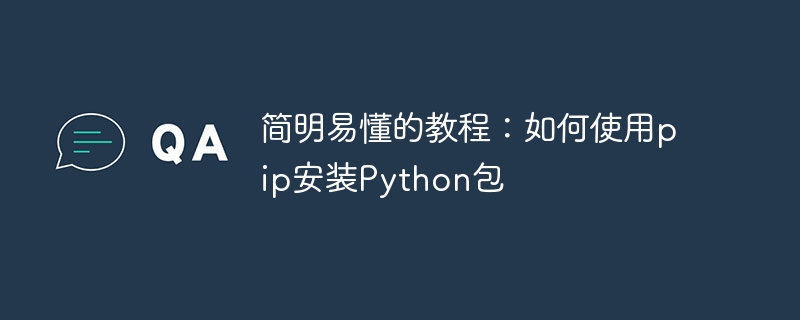

Concise and easy-to-understand tutorial: How to use pip to install Python packages
With the popularity and application of Python language in scientific computing, data analysis, web development and other fields, More and more Python packages are being developed to provide a wide variety of functions and tools. As a Python package management tool, pip greatly facilitates us to install, upgrade and delete these packages.
This tutorial will introduce in detail how to use pip to install Python packages, and attach specific code examples to facilitate readers' understanding and operation.
Step 1: Install Python and pip
First, make sure Python is installed on your computer. You can check whether it has been installed by entering the following command on the command line:
python --version
If it has been installed, the version number of Python will be displayed. If it is not installed, please go to the Python official website (https://www.python.org/) to download and install the latest version of Python.
Pip has been installed by default in the Python 2.x environment. For the Python 3.x environment, you can install pip through the following command:
python get-pip.py
Step 2: Find the package that needs to be installed
Before installing the package, you need to know the name of the package. We can find the packages that need to be installed through various channels, including official websites, communities, search engines, etc.
Step 3: Install the package using pip
Installing the package is very simple, just enter the following command on the command line:
pip install 包名
For example, to install a package named numpy, just enter the following Command:
pip install numpy
In the command line, the installation progress and related prompt information will be displayed. After the installation is completed, a success message will be displayed.
Step 4: Upgrade the package
Before using pip to install the package, we can also use it to upgrade the installed package. The command to upgrade the package is as follows:
pip install --upgrade 包名
For example, to upgrade the package named numpy, just enter the following command:
pip install --upgrade numpy
Similarly, the installation progress and related prompt information will be displayed on the command line.
Step 5: View installed packages
If you want to view installed packages, you can use the following command:
pip list
This command will list all installed Python packages and their version number.
Step 6: Delete Unnecessary Packages
If you want to delete an already installed package, you can use the following command:
pip uninstall 包名
For example, to delete a package named numpy, just enter the following Command:
pip uninstall numpy
This command will prompt you to confirm the deletion operation. Enter y to delete.
Summary:
Through the above steps, we can easily use pip to install, upgrade and delete Python packages. Using pip can greatly improve the efficiency and convenience of using Python.
Although pip is very powerful and convenient, in some cases you may encounter problems such as installation failure and version conflicts. At this time, you can consider using a virtual environment (such as virtualenv) to isolate Python environments in different projects to avoid mutual influence.
I hope this tutorial can help readers better use pip to install Python packages, and experience the convenience and fun that Python gives us during development.
The above is the detailed content of Quick start guide: How to install Python packages using pip. For more information, please follow other related articles on the PHP Chinese website!